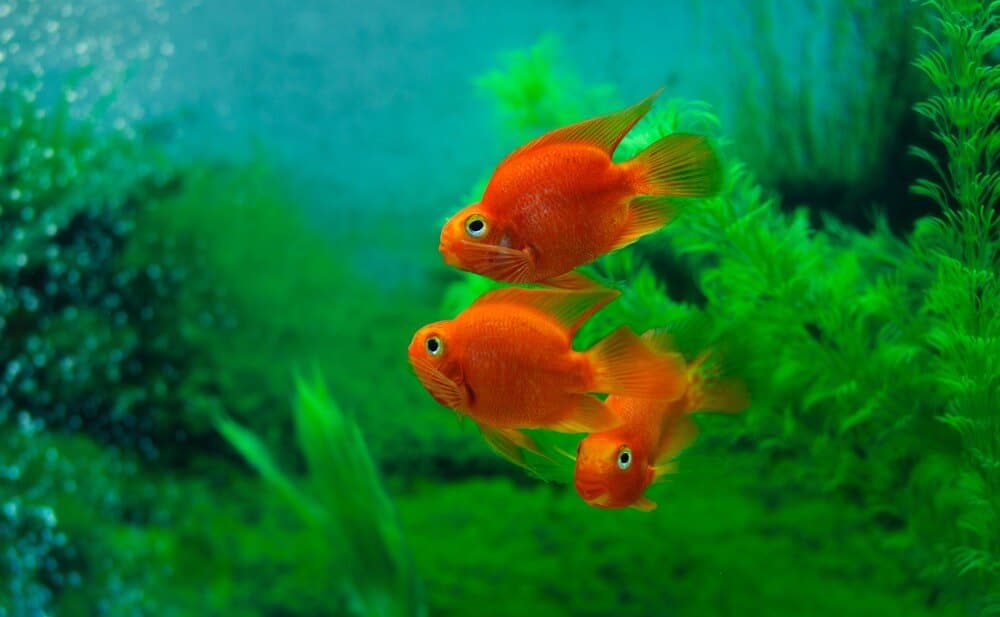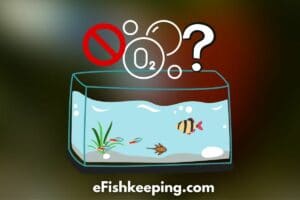Parrot fish or Blood parrot cichlids are a delightful addition to any aquarium. These charming finned friends bring visual delight, providing hours of aesthetic enjoyment. However, the question arises, what to do when Parrot fish lay eggs in the tank.
It’s important to understand that the chances of the parrotfish eggs fertilizing and hatching into baby parrotfish are quite low, particularly in home aquariums, as most male parrotfish are infertile. Although female Parrot fish can lay eggs on hard surfaces in the tank, the eggs tend to develop fungus after a few days and are eventually consumed by either the parent or other tank species.
In fish farming, hormones are used to increase the fertility rate of male parrotfish and produce a successful line of offspring. However, these technicalities and the complex breeding process are not feasible in home aquariums, so it is not advisable to expect your Parrot fish eggs to hatch in your home tank.

That said, as a Parrot fish keeper, it is worthwhile to have a general understanding of their breeding and care processes, even if the chances of successful hatching in home aquariums are low. So let’s dive in deeper and learn more!
Identifying Males versus Females
The first step is to know which fish are males and females. However, you won’t be able to determine this until they are about 1½ years old because all parrotfish look alike until then. So, you must watch them on a consistent basis.
At maturity, males will have a cone-like protrusion close to the tail with a sharp and narrow vas deferens.. When preparing to fertilize eggs, their color becomes much brighter.
For the females, their ovipositor appears like a pear, short and wide tapering at the top and slightly bulging at the bottom. They are very drab and dull in color with a rounded tail fin, appearing much smaller than the males.
Signs of Pregnancy
The hopeful parents will select each other before any obvious signs appear. While it’s advisable to keep the parents together, you want to ensure they’re compatible. Since most parrotfish males can’t reproduce, the father should be another cichlid like the red devil, purple fire mouth, red fire mouth or rohan.
Other signs include how the males will be unusually active and territorial. But, the females will be your biggest indicator. About once per month, they develop reddish spots on their boxy, bulging abdomen, which means they’ll be ready to spawn within the next 24 hours.
Nest Preparation
One of the biggest signs your parrotfish are about to lay eggs is how active both males and females are in constructing a nest, which takes about three days. Both parents guard it, keeping other fish away from the area.
Females peck and clear space at the bottom of the tank with the most desirable flat surface they can find. Males widen the entrance to the nest while also cleaning the floor and walls.
Setting Up ; Maintaining a Nursery Tank
If you see these behaviors and signs are prevalent, especially nesting, it’s imperative you set up a nursery tank and keep the parents away from other tank mates. Expect to maintain this environment for 10 to 12 weeks after the fry hatch.
When transferring the parrotfish parents to a nursery, there are several considerations. First, ensure the breeding tank has plenty of materials for the eggs to attach. Things like ceramic, glass, small flower pots, alabaster and old plates are ideal.
Water Temperature ; Flow
Then, both breeding and incubation temperatures must remain between 78.8°F and 82.4°F (26°C to 28°C). If the females need help laying eggs, you can reduce the temperature by one or two degrees. Also, check that the tank has a current strong enough for both parents but not too rapid for the brood.
Water flow will ensure proper oxygenation, an incredibly important component during this phase. Also, high levels of calcium are imperative. Adding a small amount of crushed eggs or tourmaline balls to the substrate will be sufficient.
Regular Water Testing
Many vets recommend testing the water for a 6.5 to 7.4 pH level and for high ammonia levels. Usually, this means performing a 25% water change every other day. If these levels are too high, the eggs won’t survive. If these are too low, then they won’t be able to develop or grow.
Keeping the tank clean and water pristine will reduce the occurrence of disease, parasites and other problems that can crop up from leftover food and waste.
Food ; Feeding
But, make sure you have plenty of good, nourishing foods like powdered fungus shrimp, plankton, red nematodes and pellets. Avoid overfeeding and provide many small meals throughout the day rather than huge chunks that can cause ammonia buildup. Immediately remove any excess food.
Spawning
When spawning begins, it will usually be evening and the mother will make her way to the nest. This is why it’s important to keep tank lights off, even during the day once those red spots appear on her abdomen.
As she lays her tube, the father-to-be stays nearby, fertilizing some 300 eggs. However, you can expect only 50 to 150 of them to survive. The biggest indicator of success is how the parrotfish eggs will appear clear. Any unfertilized caviar will die within two days after turning dry, cloudy and opaque.
Incubation ; Hatching
During incubation, both parents guard the offspring. Oftentimes, the female stays closest to the nest while the male guards outside. However, they will switch and take turns.
After about 24 hours, larvae begin to emerge. A few days to a week later, the fry will hatch. In the event the fertilized eggs don’t hatch, the mother releases a hormone to expedite the process. But, understand the fry won’t look like their mother at all. Chances are, they will take on most characteristics of their father.
Feeding the Fry
Once born, their first meal will be food provided by both mom and dad. They take the food offered them in the tank, grind it up in their mouths and regurgitate it to the fry. After about three days to a week, it’s up to the aquarist to feed the juveniles.
Three times per day, they must have pureed adult food or a special liquid food bought from a pet store. Their last meal of the day should be about two hours before the lights go out.
Observing the New Brood
In these early stages, sometimes the parents are aggressive toward one another for dominance and supremacy. This also comes with the potential for the parents to eat the young, beginning at the caviar stage. This is especially true if the brood develops some kind of disease.
Unfortunately, it’s this eating of their young that causes great concern when parrotfish lay eggs. Any unviable eggs become food and the parents will eat them without warning. You may have to remove the caviar and take them to a vet for a disease and parasite check.
If they are okay, then you’ll have to house the parents away from the brood until they are old enough to migrate to the main tank.
Missing the Deadline
In the event the female already laid eggs with subsequent fertilization, you have to take some precautions. Investing in a tank divider will be the best way to protect the parents while keeping the other attacking tank species away. It’s a useful method for reducing stress for the parents, protecting the brood and being able to control the conditions.
Final Thoughts
Although Parrot fish are cute and make good parents, unfortunately the likelihood of their eggs to hatch into offspring is quite less. But whatever is the case, it’s still a good idea to provide the blood parrot fish the right conditions to thrive and avoid any stressful conditions for them.
And if you are serious about breeding them, then you will have to take a proactive approach, which means setting up a nursery tank and controlling the water parameters as much as possible.
It’s going to require keen observation and paying attention to the behavior of your fish. It will be better if you can remove them from the main tank before they spawn. But, if you miss the deadline, you will have to ensure you keep all other tank mates away.
Recommended Read:
- Why Parrot Fish Fight & How To Stop It? (Explained!)
- Top 10 Blood Parrot Cichlid Tank Mates (With Pictures!)
Hi! I’m Praveen Ghoshal, the founder of eFishkeeping.com. Inspired by my Dad, I got interested in fishkeeping when I was a kid. Since then, I have been involved with this hobby. Currently, I have 3 fish tanks at our home, and I enjoy this hobby with my full family. Read more about me here.







